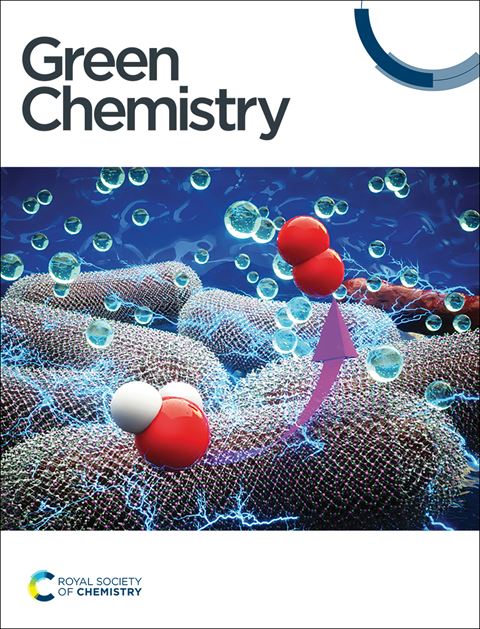Multi-synergistic regulation of hard carbon via a green bioengineering strategy to achieve high-capacity sodium-ion storage†
IF 9.3
1区 化学
Q1 CHEMISTRY, MULTIDISCIPLINARY
引用次数: 0
Abstract
Biomass-derived hard carbon (HC) is the most promising anode material for commercial sodium-ion batteries (SIBs). However, the commercialization of HC still faces technical issues related to its insufficient reversible capacity and low initial coulombic efficiency. Although some techniques have been developed to circumvent these issues, they suffer from drawbacks such as complex preparation processes, environmental unfriendliness, and high processing costs. Herein, an ecofriendly bioengineering strategy based on the microstructure and composition regulation of bamboo as an HC source has been reported. The designed biomass-derived HC anode has a high reversible capacity (428.21 mA h g−1) and outstanding initial Coulomb efficiency (90.72%) at 30 mA g−1 superior to that of previously reported plant-based HC electrodes. Self-growing Coriolus versicolor (CV), a bothersome fungus, was ingeniously used to regulate the lignin content of the bamboo precursor generating abundant closed pores and increasing porosity, and the removed lignin can be converted into CV carbon fibers in a green manner. Moreover, CV carbon fibers with their hyperbranched structure provide a natural interpenetrative path for fast ion diffusion and electron transport as well as rich sodium-ion storage sites, thereby boosting their electrochemical performance. Note that the ash content in bamboo could be decreased via this natural bioengineering process without using common acid/base treatments. This study provides a cost-effective and green approach to synchronously modulate the microstructure and composition of biomass toward high-performance biomass-derived SIB anodes.

通过绿色生物工程策略实现硬碳的多协同调节,以实现高容量钠离子存储†
生物质硬碳(HC)是最有前途的商用钠离子电池(sib)负极材料。但是,HC的商业化还面临着可逆容量不足、初始库仑效率低等技术问题。虽然已经开发了一些技术来规避这些问题,但它们存在诸如制备过程复杂、对环境不友好和加工成本高等缺点。本文报道了一种基于竹材结构和组成调控的生态生物工程策略。设计的生物质来源的HC阳极具有高可逆容量(428.21 mA h g−1)和突出的30 mA g−1时的初始库仑效率(90.72%),优于先前报道的植物基HC电极。利用自生长型木质素(CV)调节竹前驱体中木质素的含量,产生大量的封闭孔隙,增加孔隙度,去除的木质素可以以绿色的方式转化为CV碳纤维。此外,CV碳纤维的超支化结构为快速离子扩散和电子传递提供了自然的互穿路径,并提供了丰富的钠离子存储位点,从而提高了其电化学性能。值得注意的是,通过这种天然生物工程工艺可以降低竹子的灰分含量,而无需使用普通的酸/碱处理。该研究为同步调节生物质的微观结构和组成以制备高性能生物质衍生的SIB阳极提供了一种具有成本效益和绿色的方法。
本文章由计算机程序翻译,如有差异,请以英文原文为准。
求助全文
约1分钟内获得全文
求助全文
来源期刊

Green Chemistry
化学-化学综合
CiteScore
16.10
自引率
7.10%
发文量
677
审稿时长
1.4 months
期刊介绍:
Green Chemistry is a journal that provides a unique forum for the publication of innovative research on the development of alternative green and sustainable technologies. The scope of Green Chemistry is based on the definition proposed by Anastas and Warner (Green Chemistry: Theory and Practice, P T Anastas and J C Warner, Oxford University Press, Oxford, 1998), which defines green chemistry as the utilisation of a set of principles that reduces or eliminates the use or generation of hazardous substances in the design, manufacture and application of chemical products. Green Chemistry aims to reduce the environmental impact of the chemical enterprise by developing a technology base that is inherently non-toxic to living things and the environment. The journal welcomes submissions on all aspects of research relating to this endeavor and publishes original and significant cutting-edge research that is likely to be of wide general appeal. For a work to be published, it must present a significant advance in green chemistry, including a comparison with existing methods and a demonstration of advantages over those methods.
 求助内容:
求助内容: 应助结果提醒方式:
应助结果提醒方式:


